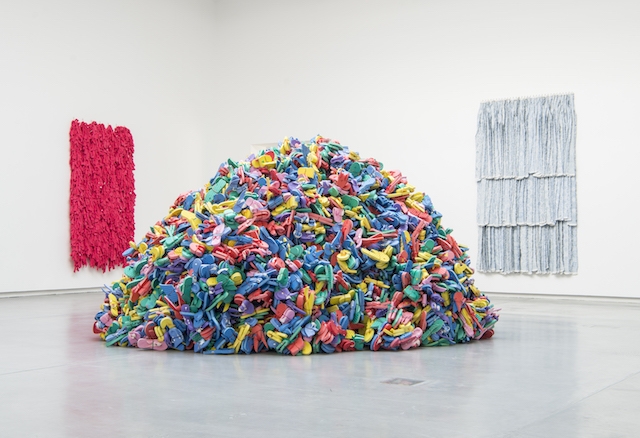Hassan Sharif’s status as a pioneer of conceptual art in the Middle East, and arguably the most important artist working in the United Arab Emirates when he died in 2016, was recently honoured with a major retrospective at the Sharjah Art Foundation. Encompassing more than 40 years of production, the wide-ranging exhibition included everything from the cartoons and caricatures Sharif made for local news publications in the mid-1970s to works left unfinished in his studio upon his death, just as he was achieving wider international recognition.
Imaginatively titled after a 1989 quote from the artist’s writings about the durational and repetitive way in which he worked, I Am The Single Work Artist was curated by Hoor Al Qasimi and divided into seven chapters, whose names were also inspired by Sharif’s own words. In the first gallery dedicated to the exhibition at the foundation’s Al Mureijah Square complex (the show also spills over into the nineteenth-century Bait Al Serkal townhouse), ‘Hassan’s Atelier’ replicates the artist’s studio at the time of his death. Sketches, works in progress, pieces he kept on view (including a 1981 portrait of his brother Hussain), instructions that served as the starting point for most of his works, and cardboard and metal assemblages hang on the walls. A big worktable, with open storage areas underneath, reveals the wide array of objects and materials – including fabric and wire – that Sharif employed.
The presentation for ‘I’m an object maker’ in Gallery 5 features many of the largest-scale works in the show. These include an installation of interlinked whisk brooms (Broom, 2016) covering a whole wall, an accumulation of bent aluminium cookie sheets (555, 2016) wired together and displayed like a waterfall cascading onto the floor and thousands of Sharif’s diaristic photographs of ordinary things, strung together and suspended above the digital printer that had produced the dangling prints. Related to the strategies of the Nouveaux Réalistes in the 1960s, and particularly the working methods of the French artist Arman, these works exemplify Sharif’s interest in repetition. Cotton (2013), a glued-together glob of cotton and the accompanying video of the artist making it, speaks to the durational aspect of his creative process.
The section ‘Performance is good’ reveals Sharif’s roots in conceptual and performance art. Created from the late-1970s through to the mid-1980s, the performance pieces are documented by mostly black-and-white photographs laid out in grids, similar to the way that Gilbert & George and Vito Acconci presented their actions. My Body in the Store (1983) capture the artist’s movement through a souk, while the four photographs of One Day Exhibition (1984) record a temporary show of Sharif’s drawings on a city wall. Conceptual pieces like Reading Newspaper in Taxi (1985) document Sharif’s daily activities with written notes and sketches, which he then mounted and framed as art.
Piles of tied-together plastic cups, wads of paper bundled in fabric and broken toys connected with wire fill the gallery titled ‘I’m loyal to colour’. An accumulation of readymade plastic combs (Combs, 2016) hung en bloc look like an abstract painting, while also echoing Annette Messager’s constellations of photos. Nearby, cut-up and wire-hung pink bath towels (Towel 3, 2013) provide a new take on monochrome painting, while a mound of cut and wire-bound plastic slippers (Slippers and Wire, 2009) brings to mind Mario Merz’s igloos constructed with found materials, and more broadly the arte povera strategy of employing everyday objects to simple ends.
A permanently sealed box dating from 1983, My Little Tiny Box, lends its name to Gallery 2, where it is included alongside scores of other boxed and bound sculptural pieces resembling crudely assembled books and packages. My Little Tiny Box relates to the enigmatic sculptural object With Hidden Noise (1916) by Marcel Duchamp, one of Sharif’s artistic heroes and whose texts he translated into Arabic for the benefit of his peers. Adopting more recent conceptual art strategies, the section ‘…so I created a semi system’ focused on Sharif’s obsessive use of mathematics and chance in works from 1983 to 2015. He analysed the handwriting in letters using grids, points of which were connected by lines to create random geometric forms that were then fabricated as paintings and wooden sculptures. Other instructional pieces from the same period, rendered as paintings and works on paper, evoke the experimental work of such American minimalist artists as Sol LeWitt and Fred Sandback.
Sharif was among the first regional artists to explore the conceptual strategies of the European and American avant-garde. In doing so, he opened doors through which others followed: in 1980 he cofounded The Emirates Fine Art Society, whose role was recognised in 2002 when Sharif, his brother Hussain and his protégés Mohammed Kazem, Abdullah Al Saadi and Mohammed Ahmed Ibrahim were shown together in the exhibition 5 UAE at the Ludwig Forum for International Art, Aachen. Yet for all that the artworld is still catching up with Sharif’s influence and the significance of his dialogue with Modernism and postmodernism, this retrospective makes clear that, regardless of the style in which he worked, Sharif made work that was always his own.
The final part of the expansive exhibition, ‘Things in my room’ at Bait Al Serkal, brings together a number of themes under one roof. The figurative method of his early drawings, including introspective self-portraits and caricatures of friends, and later paintings of everyday objects, rendered in loose, expressive painted brushstrokes, are contrasted with more organic accumulations of materials. Displayed in intimate rooms, down long corridors and in shelflike nooks, his marvellous creations turn the former residence into a cabinet of curiosities. It is a fitting setting in which to display a lifetime’s worth of work both personal and experimental.
Hassan Sharif: I Am The Single Work Artist at Sharjah Art Foundation, 4 November – 3 February
From the Spring 2018 issue of ArtReview Asia
